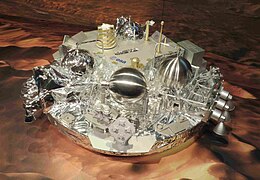
Back سكيابارلي (مركبة) Arabic Mòdul de descens Schiaparelli Catalan Schiaparelli (Marslander) German Schiaparelli EDM Spanish Schiaparelli Estonian Schiaparelli EDM Basque سطحنشین ایدیام اسکیاپارلی Persian Schiaparelli (luotain) Finnish Schiaparelli (engin spatial) French סקיאפארלי (נחתת) HE
 Model of Schiaparelli lander at ESOC (2016) | |||||||||||||
| Mission type | Mars lander / technology demonstrator | ||||||||||||
|---|---|---|---|---|---|---|---|---|---|---|---|---|---|
| Operator | ESA · Roscosmos | ||||||||||||
| COSPAR ID | 2016-017A | ||||||||||||
| SATCAT no. | 41388 | ||||||||||||
| Website | ESA mission website | ||||||||||||
| Mission duration | Planned: 2 to 8 sols[1] (surface stay) Preceded by 3 day coast between separation and entry[2] | ||||||||||||
| Spacecraft properties | |||||||||||||
| Manufacturer | Thales Alenia Space | ||||||||||||
| Launch mass | 577 kg (1,272 lb)[3] | ||||||||||||
| Dimensions | Diameter: 2.4 m (7.9 ft)[3] Height: 1.8 m (5.9 ft)[3] | ||||||||||||
| Start of mission | |||||||||||||
| Launch date | 14 March 2016, 09:31 UTC | ||||||||||||
| Rocket | Proton-M/Briz-M | ||||||||||||
| Launch site | Baikonur Site 200/39 | ||||||||||||
| Contractor | Khrunichev | ||||||||||||
| End of mission | |||||||||||||
| Disposal | Crash-landed | ||||||||||||
| Destroyed | 19 October 2016 | ||||||||||||
| Landing site | Meridiani Planum, Mars 2°03′S 6°13′W / 2.05°S 6.21°W | ||||||||||||
| |||||||||||||
ExoMars programme | |||||||||||||
Schiaparelli EDM (Italian: [skjapaˈrɛlli]) was a failed Entry, Descent, and Landing Demonstrator Module (EDM) of the ExoMars programme—a joint mission of the European Space Agency (ESA) and the Russian Space Agency Roscosmos.[4] It was built in Italy and was intended to test technology for future soft landings on the surface of Mars.[5] It also had a limited but focused science payload that would have measured atmospheric electricity on Mars and local meteorological conditions.[2][6][7]
Launched together with the ExoMars Trace Gas Orbiter (TGO) on 14 March 2016, Schiaparelli attempted a landing on 19 October 2016. Telemetry signals from Schiaparelli, monitored in real time by the Giant Metrewave Radio Telescope in India (and confirmed by Mars Express), were lost about one minute from the surface during the final landing stages.[8] On 21 October 2016, NASA released an image by the Mars Reconnaissance Orbiter showing what appears to be the lander's crash site.[9] The telemetry data accumulated and relayed by ESA's ExoMars Trace Gas Orbiter and Mars Express were used to investigate the failure modes of the landing technology employed.
- ^ "Schiaparelli science package and science investigations". European Space Agency. 10 March 2016.
- ^ a b Cite error: The named reference
eoportalwas invoked but never defined (see the help page). - ^ a b c Cite error: The named reference
EDL-demonstrator-modulewas invoked but never defined (see the help page). - ^ Patterson, Sean (8 November 2013). "ESA Names ExoMars Lander 'Schiaparelli'". Space Fellowship.
- ^ "The European probe to Mars takes off today from Turin Airport". La Stampa. 23 December 2015.
- ^ Cull, Selby (September 2005). "Static Electricity, Toxic Dust, and the Red Planet: How NASA is Preparing to Send Humans to Mars". Journal of Young Investigators. Retrieved 4 November 2016.
- ^ "The European Space Exploration Programme Aurora". European Space Agency. Retrieved 4 November 2016.
- ^ "ExoMars TGO reaches Mars orbit while EDM situation under assessment". European Space Agency. 19 October 2016. Retrieved 19 October 2016.
- ^ Chang, Kenneth (21 October 2016). "Dark Spot in Mars Photo Is Probably Wreckage of European Spacecraft". The New York Times. Retrieved 21 October 2016.